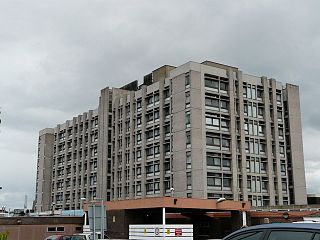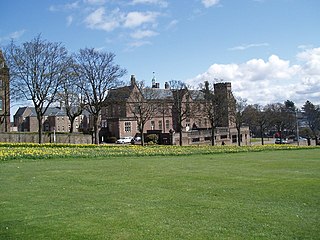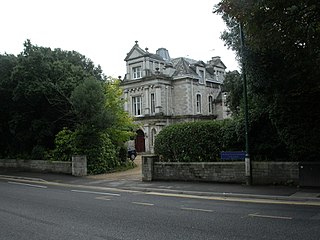
Truro is a cathedral city and civil parish in Cornwall, England. It is Cornwall's county town, sole city and centre for administration, leisure and retail trading. Its population was 18,766 in the 2011 census. People of Truro can be called Truronians. It grew as a trade centre through its port and as a stannary town for tin mining. It became mainland Britain's southernmost city in 1876, with the founding of the Diocese of Truro. Sights include the Royal Cornwall Museum, Truro Cathedral, the Hall for Cornwall and Cornwall's Courts of Justice.

Newquay is a town on the north coast in Cornwall, in the south west of England. It is a civil parish, seaside resort, regional centre for aerospace industries with a spaceport, and a fishing port on the North Atlantic coast of Cornwall, approximately 12 miles (19 km) north of Truro and 20 miles (32 km) west of Bodmin.

The Royal Hospital Chelsea is a retirement home and nursing home for some 300 veterans of the British Army. Founded as an almshouse, the ancient sense of the word "hospital", it is a 66-acre (27 ha) site located on Royal Hospital Road in Chelsea. It is an independent charity and relies partly upon donations to cover day-to-day running costs to provide care and accommodation for veterans.

Saint Mary's Hospital is a hospital in Manchester, England. It is part of Manchester University NHS Foundation Trust. Founded in 1790, St Mary's provides a range of inter-related services specifically for women and children.

Whipps Cross University Hospital is a large university hospital in the locality of Whipps Cross in Leytonstone and is within Epping Forest in the London Borough of Waltham Forest, London, England. It is managed by Barts Health NHS Trust.

Manchester Royal Infirmary (MRI) is a large NHS teaching hospital in Chorlton-on-Medlock, Manchester, England. Founded by Charles White in 1752 as part of the voluntary hospital movement of the 18th century, it is now a major regional and national medical centre. It is the largest Hospital within Manchester University NHS Foundation Trust, and based on its Oxford Road Campus in South Manchester where it shares a site with the Royal Manchester Children's Hospital, Manchester Royal Eye Hospital and Saint Mary's Hospital as well as several other educational and research facilities. The Hospital is also a key site for medical educational within Manchester, serving as a main teaching hospital for School of Medical Sciences, University of Manchester.

The Western General Hospital is a health facility at Craigleith, Edinburgh, Scotland. It is managed by NHS Lothian.

Southmead Hospital is a large public National Health Service hospital, situated in the area of Southmead, though in Horfield ward, in the northern suburbs of Bristol, England. It is part of the North Bristol NHS Trust. The 800-bed Brunel Building opened in May 2014, to provide services, which transferred from Frenchay Hospital in advance of its closure. The hospital site covers 60 acres (24 ha).

The Bristol Royal Infirmary, also known as the BRI, is a large teaching hospital in the centre of Bristol, England. It has links with the nearby University of Bristol and the Faculty of Health and Social Care at the University of the West of England, also in Bristol.

The Royal Infirmary of Edinburgh (RIE), often known as the Edinburgh Royal Infirmary (ERI), was established in 1729 and is the oldest voluntary hospital in Scotland. The new buildings of 1879 were claimed to be the largest voluntary hospital in the United Kingdom, and later on, the Empire. The hospital moved to a new 900 bed site in 2003 in Little France. It is the site of clinical medicine teaching as well as a teaching hospital for the University of Edinburgh Medical School. In 1960, the first successful kidney transplant performed in the UK was at this hospital. In 1964, the world's first coronary care unit was established at the hospital. It is the only site for liver, pancreas and pancreatic islet cell transplantation and one of two sites for kidney transplantation in Scotland. In 2012, the Emergency Department had 113,000 patient attendances, the highest number in Scotland. It is managed by NHS Lothian.

Doncaster Royal Infirmary is a district general hospital of 800 beds, located in Doncaster, South Yorkshire, England. It is managed by Doncaster and Bassetlaw Teaching Hospitals NHS Foundation Trust.

The Royal Cornwall Hospital, formerly and still commonly known as the Treliske Hospital, is a medium-sized teaching hospital in Treliske, on the outskirts of Truro, Cornwall, England. The hospital provides training services for the University of Exeter Medical School. It is managed by the Royal Cornwall Hospitals NHS Trust.

Leicester General Hospital (LGH) is a National Health Service hospital located in the suburb of Evington, about three miles east of Leicester City Centre, and is a part of University Hospitals of Leicester NHS Trust. It has approximately 430 beds. The hospital is the largest employer in the area.

The Royal Victoria Infirmary (RVI) is a 673-bed tertiary referral hospital and research centre in Newcastle upon Tyne, England, with strong links to Newcastle University. The hospital is part of the Newcastle upon Tyne Hospitals NHS Foundation Trust and is a designated academic health science centre.

Bristol General Hospital was a healthcare facility in Guinea Street, Harbourside, Bristol, in the south west of England. It opened in 1832, and closed in 2012. The BGH was managed by the University Hospitals Bristol NHS Foundation Trust. The building has since been converted into apartments.

Dundee Royal Infirmary, often shortened to DRI, was a major teaching hospital in Dundee, Scotland. Until the opening of Ninewells Hospital in 1974, Dundee Royal Infirmary was Dundee's main hospital. It was closed in 1998, after 200 years of operation.

The Royal Victoria Hospital was a hospital situated on two sites in Bournemouth, England. The primary site was in Boscombe but for a period of time it was merged with a Westbourne site. The Westbourne site was the first named Royal Victoria Hospital of the two but the name was applied to both sites after merger in 1911. It has had several name changes during its history.

Mary Hannah Frances Ivens CBE FRCOG was an obstetrician and gynaecologist who was the first woman appointed to a hospital consultant post in Liverpool. During the First World War she was chief medical officer at the Scottish Women's Hospital at Royaumont, northeast of Paris. For her services to the French forces she was awarded a knighthood in France's Legion of Honour and the Croix de Guerre.

Dulwich Community Hospital was a hospital located in Dulwich, in South London.

The RAF Hospital Torquay, was a medical facility run by the Royal Air Force (RAF) in the Torquay suburb of Babbacombe, Devon, England, during the Second World War. The RAF requisitioned the Palace Hotel, and set about converting it into a hospital, which opened in 1939. The hospital was subjected to at least two bombing raids in October 1942 and January 1943. The first raid resulted in at least 21 deaths, with the function of the hospital ceasing immediately and all work being transferred to other RAF Hospitals. It was never used as a hospital again, and after the war, was returned to civilian use.





















